Click here for Master Tutorials
Click here for Guest History Navigation
Guest History Tabs | |
|---|---|
| Guest History Master Functions | |
|---|---|
Tabs Available for Guest History
The basic master information on all types of masters are similar. Each master type has different tabs available where appropriate. As shown in this sample, tabs outlined in color hold master-specific information. When viewing a single guest history record on a screen such as Change, the Contact Detail tab information is displayed above the other tabs.
Contact Detail Tab
View the guest's contact information. This is a separate tab when viewing the Analysis grid as shown below; however when viewing Add or Change
Guest screens, this information is displayed above the other tabs.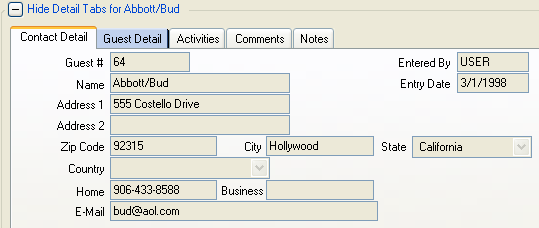
- Guest#
- The guest history number is an eight-character, alphanumeric field that uniquely identifies each guest record. This number is automatically assigned by the system and CANNOT be changed.
- Entered By
- When a guest history master is added to the database, this field is stamped by the system to identify the logon name of the user who entered the information.
- Name
- Enter the first and last name of the guest using any 24 alphanumeric characters (such as Bud Abbot or Clive Owen).
- Entry Date
- When a guest history master is added to the database, this field is stamped by the system to identify the system date when the information was entered.
- Address 1 and 2
- Enter the street address of the guest using any 24 alphanumeric characters.
- City
- Enter the city where the guest is located using any 16 alphanumeric characters.
- State
- Select the state where the guest is located using the drop-down list. When the first letter of the desired state is typed in to the field directly, the system searches the CB table and displays the closest match. Once a state is displayed in this field, use the up and down arrows to scroll through the list individually without using the mouse.
- Zip
- Enter the Zip Code using any 10 alphanumeric characters prior to the City and State fields for the system to automatically fill in those fields for the user. Letters are allowed for Canadian and European addresses.
- Country
- Select the country where the guest is located using the drop-down list. When the first letter of the desired country is typed in to the field directly, the system searches and displays the closest match. Once a country is displayed in this field, use the up and down arrows to scroll through the list individually without using the mouse.
- Home and Business
- Enter the home and business telephone numbers of the guest using any 12 alphanumeric characters. Formats allowed are 800/555-1212, 800-555-1212, 8005551212, and 011945551212.
- Enter the email address of the guest using any 40 alphanumeric characters. The system recognizes that an e-mail address must contain the "@" symbol and displays an error when not entered.
- Don't Mass E-mail
- Check to allow the guest to opt out of mass e-mail marketing. Allowing this restriction abides by all current regulations for anti-SPAM.
- External Documents - T2 Module Required
- This link allows external files to be attached to the guest history master. Use this feature to attach detailed information about the guest. The following file types are supported: Txt, Doc, Docx, Htm, Html, Xls, Jpg, Bmp, Gif, and more. The documents can be viewed as long as the workstation has the application installed that displays that file extension.
- To attach a file, save it to the \RDP\RDP<xx>\MasterDocs\Guest folder, using the guest history number as the file name. For example, if the file created was for the guest #1234 in the RDP01 directory, the file and location would be \RDP\RDP01\MasterDocs\Guest\1234.doc (the file extension will change based on the program it was created in).
- If more than document is needed for the master, enter the master number followed by 1, 2, 3, etc. For example, for guest history record 101, enter the file name as 101-1, 101-2, 101-3, and a prompt appears allowing the different files to be selected.
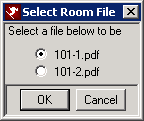
- If the file does not exist, the following error message will appear with the file path location when the link is clicked. Note: The file location will display the UNC path, however, the file can be saved to the RDP drive (usually R:\ or F:\).
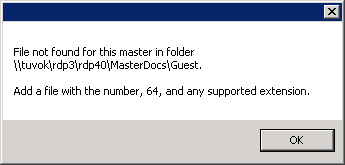
- External Pictures - T2 Module Required
- This link allows external pictures to be attached to the guest history master. The following file types are supported: Txt, Doc, Docx, Htm, Html, Xls, Jpg, Bmp, Gif, and more. The pictures can be viewed as long as the workstation has the application installed that displays that file extension.
- To attach a picture, save it to the \RDP\RDP<xx>\MasterPics\Guest folder, using the guest history number as the file name. For example, if the file created was for the guest # 1234 in the RDP01 directory, the file and location would be \RDP\RDP01\MasterPics\Guest\1234.jpg.
- If more than picture is needed for the master, enter the master number followed by 1, 2, 3, etc. For example, for guest history record 101, enter the file name as 101-1, 101-2, 101-3, and a prompt appears allowing the different pictures to be selected.

- If the file does not exist, the following error message will display showing the file path location when the link is clicked. Note: The file location will display the UNC path, however, the file can be saved to the RDP drive (usually R:\ or F:\).
Guest Detail Tab
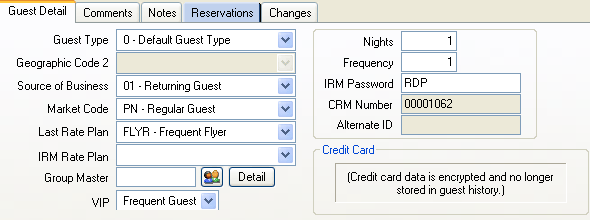
- Guest Type
- Guest type is an optional way to categorize guest history masters. For example, a guest type can be used to distinguish those people who call for information about a property from people who book reservations. The guest type may be used to filter mailing labels or e-mails. The standard guest types in table CA are:
- 0 - Default Guest Type
- 1 - Returning Guest
- 2 - Brochure Request
- 3 - Chamber of Commerce
- IRM - Internet
- Geographic Code 2 (Table CC)
- Geographic code 1 or state, Table CB, designates a two-letter abbreviation for North American and Canadian states. Geographic code 2 can be used to group states into regions. For example, New Mexico, Arizona, California and Nevada could be assigned to a "SW - Southwest" region.
- Source of Business (Table CD)
- A user definable field that indicates how the guest learned about the property, such as in-house marketing, word of mouth, returning guest, or walk-in.
- Market Code (Table CF)
- A user definable field that describes the type of guest, such as Transient, F.I.T., Group, Corporate, Guest of Owner, etc. Codes define the type of guest staying at your property, and can be used to analyze the market segments being targeted.
- Last Rate Plan
- When a reservation is checked-out, this field is updated with the current rate plan on the reservation. Next time this guest makes a reservation, this rate plan is highlighted as the one to use.
- IRM Rate Plan
- If using the Internet Reservation Module (IRM), this is the only rate plan allowed to be used for this guest.
- Group Master

- This is the default group for this guest which is used on the next reservation made for this guest. Click the Group button (show in title) to open the Find Group screen and allow for selection from a list. Click Detail to view the Group Detail screen which is actually the Change Group screen in read-only format.
- VIP
- See VIP for details.
- Nights
- Total number of nights the guest has accumulated during all stays.
- Frequency
- Displays the number of stays for this guest.
- IRM Password
- When a guest makes their first reservation on the IRM, they enter a password, which is stored here. This can be changed if needed and the guest notified of the change.
- CRM# (Only available if the Customer Relationship Management (RX) module is installed.)
- Allows the search by this field in addition to the Name, Number, and E-mail fields.
- Contact ID
- Allows the tracking of contacts within the CRM and the Guest History Master
- Credit Card Type
- Type of credit card last used when a reservation is checked-out for this guest, such as VISA, MasterCard, American Express, etc.
- Credit Card Number
- Credit card number last used when a reservation is checked-out for this guest.
- Credit Card Exp. Date
- Credit card expiration date last used when a reservation is checked-out for this guest.
Comments Tab
The nine guest history comment fields (same as Comments 1 - 9 on the reservation details) can be customized to the property's needs. The headings for these fields can be changed to reflect the appropriate information using System | Comment Labels. These same Comments 1 - 9 display on a reservation's Comment tab in addition to Comments 10 - 17 which are specific to the reservation (and not the guest history record).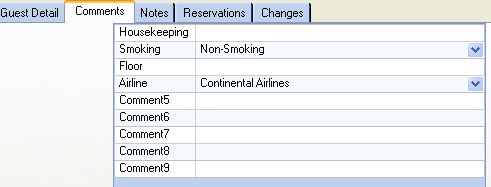
Notes Tab
Any free text entries pertaining to the selected master are displayed in this section.
- Add
- Click the Add link on the Notes tab to access the Add Note screen.
Type in free text and save to file the note on the guest history
record. The login information and date/time of save are recorded
as well.
- Change
- Click the Change link on the Notes tab to access the notes and
render the information editable. Type in free text and save to
file the updated note(s) on the guest history record. The login
information and date/time of save are recorded as well.
Reservations Tab
Display reservations on the selected group master by reservation
status. Use the drop-down to select a single
status (Future, In-house, Active History, Non-active History, or Cancelled)
or of all active, non-cancelled reservations ("Future, In-House, and
Active"). The entire history of the group is available using various
status searches. Double-click any reservation in the grid to open the Change Reservation
screen.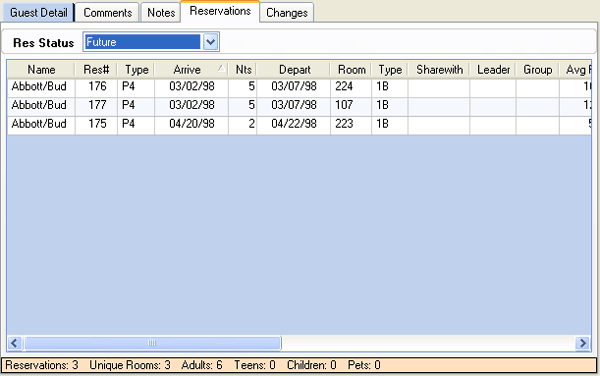
- Res Status
- Use the drop-down to select a single status (Future, In-house, Active History, Non-active History, or Cancelled) or of all active, non-cancelled reservations ("Future, In-House, and Active"). The entire history of the group is available using various status searches.
Changes Tab
When the Change Tracking Module (S7) is installed, changes made to
guest history masters in RDPWin are tracked.
Change Tracking Analysis and
Summary
information is also available.
The
system tracks information on the user making the changes as well. Some
properties assign group logons for front desk, audit staff, accounting.
To assure the most accurate information is recorded for Change Tracking,
properties should
create and
maintain individual logons for each and every user. See
Change Tracking Overview for more
details.
- Summary View
- When the Summary View radio button is selected and a guest history
master is
changed using RDPWin, basic change information is
displayed on the tab. Each row in the grid represents a time when
a guest record was changed and saved. One or many changes can be
associated with a single row. Fields available on this tab
are always Date Changed (includes time), Changed By (based on logon of
user), Name, Type, Frequency, Nights, CRM#, and contact information.
The original guest record is always displayed at the bottom of the grid. Any changes made thereafter are displayed in order with the latest on top. The grid cannot be sorted, filtered, or reordered. For additional reporting and data manipulation, use Change Tracking Analysis and/or Change Tracking Summary.
When multiple changes are made on the same date and display the same time in the Date Changed grid, view the detail to see the actual, official time including the seconds. In the sample below, the original agent record was made on 03/01/98 at 12:00 a.m. Multiple changes were made on March 1st later that day.
- View Detail Button
- While in Summary View, click the "View Detail" button or double-click any row to display the details on the Changes screen. The sample screen below shows the credit card number, card type, and expiration date were all changed by User USER on March 1st at 37 seconds after 4:42 p.m.
- View Guest Button
- While in Summary View, click the "View Guest" button to display the
guest history record in read-only format. The information
displayed is the same as that displayed on the
Change
Guest Master screen.
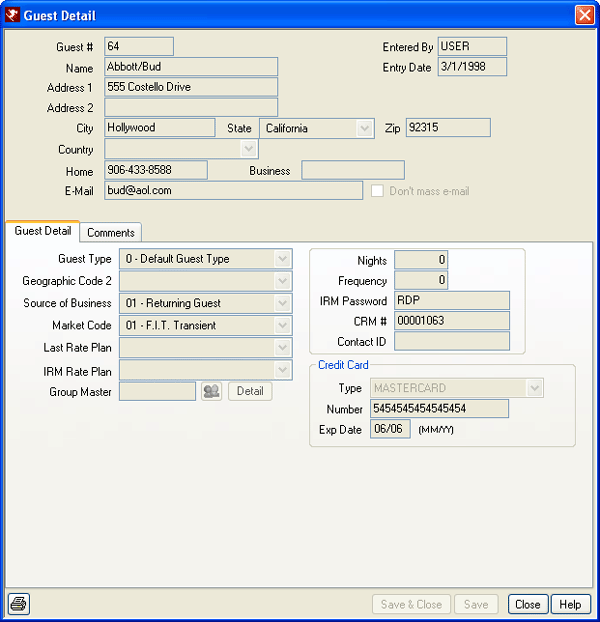
- Detail View
- When the Detail View radio button is selected and a guest is
changed using RDPWin, each row represents a single change regardless of whether or not
multiple changes were made during the same Change session. The Date Changed column
is always displayed, along with the field name changed, the original and
new value of that field, and the user's logon information. This
information is the same as displayed on the Changes screen.
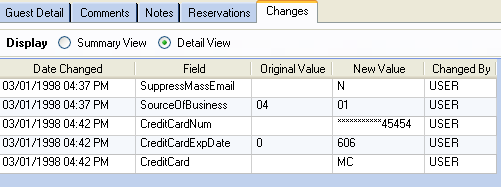
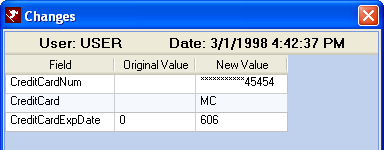 |
Click these links for Frequently Asked Questions or Troubleshooting assistance.
© 1983-2009 Resort Data Processing, Inc. All rights reserved.